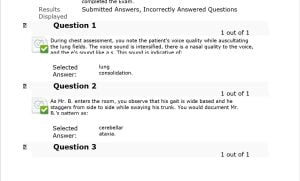COURSE
NURS 6512 Advanced Health Assessment and Diagnostic
Number of Questions 1 – 119
Questions
- Question: During chest assessment, you note the patient’s voice quality while auscultating the lung fields. The voice sound is intensified, there is a nasal quality to the voice, and the e’s sound like a s. This sound is indicative of:
- Question: As Mr. B. enters the room, you observe that his gait is wide based, and he staggers from side to side while swaying his trunk. You would document Mr. B.’s pattern as:
- Question: Diabetic peripheral neuropathy will likely produce:
- Question: Montgomery tubercles are most prominent in the breasts of:
- Question: Which one of the following techniques is used to detect a torn meniscus?
- Question: Ulnar deviation and boutonniere deformities are characteristic of:
- Question: A pulsation that is diminished to the point of being barely palpable would be graded as:
- Question: When palpating joints, crepitus may occur when:
- Question: While collecting personal and social history data from a woman complaining of breast discomfort, you should question her regarding:
- Question: Postural hypotension is defined as a _______ when the patient stands, compared with sitting or supine readings.
- Question: A positive straight leg raise test usually indicates:
- Question: The best way to ease the apprehension of a 3-year-old child before a physical examination is to:
- Question: An examiner has rotated a brush several times into the cervical os. The brush was withdrawn and stroked lightly on a glass slide. The slide was sprayed with fixative. Which type of specimen requires this technique for collection?
- Question: The finger-to-nose test allows assessment of:
- Question: Which medical condition would exclude a person from sports participation?
- Question: Palpation of epitrochlear nodes is part of the:
- Question: A grade IV mitral regurgitation murmur would:
- Question: The musculoskeletal examination should begin when:
- Question: Facial muscle or tongue weakness may result in:
- Question: The physical assessment technique most frequently used to assess joint symmetry is:
- Question: Part of the screening orthopedic component of the examination includes evaluating the person while he or she is:
- Question: The Mini-Mental State Examination should be administered for the patient who:
- Question: The Mini-Mental State Examination:
- Question: Which of the following statements is true regarding the examination of peripheral arteries?
- Question: Which portion of the physical examination is best done with the patient standing?
- Question: In the adult, the apical impulse should be most visible when the patient is in what position?
- Question: You are conducting a clinical breast examination for your 30-year-old patient. Her breasts are symmetrical with bilateral, multiple tender masses that are freely moveable with well-defined borders. You recognize that these symptoms and assessment findings are consistent with:
- Question: During a routine prenatal visit, Ms. T. was noted as having dependent edema, varicosities of the legs, and hemorrhoids. She expressed concern about these symptoms. You explain to Ms. T. that her enlarged uterus is compressing her pelvic veins and her inferior vena cava. You would further explain that these findings:
- Question: To hear diastolic heart sounds, you should ask patients to:
- Question: A red, hot swollen joint in a 40-year-old man should lead you to suspect:
- Question: While interviewing a 70-year-old female clinic patient, she tells you that she takes ginkgo biloba and St. John’s wort. You make a short note to check for results of the:
- Question: Loss of immediate and recent memory with retention of remote memory suggests:
- Question: When the Goodenough-Harris Drawing Test is administered to a child, the evaluator principally observes the:
- Question: Palpation of a normal prostate in an older adult is likely to feel:
- Question: One of the most important aspects to consider in the orthopedic screening examination is:
- Question: A 12-year-old boy relates that his left scrotum has a soft swollen mass. The scrotum is not painful upon palpation. The left inguinal canal is without masses. The mass does transilluminate with a penlight. This collection of symptoms is consistent with:……….
ANSWERS

………..please click the icon below to purchase full exam answers at $30